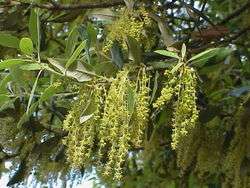Mediterranean woodlands and forests
The Mediterranean woodlands and forests is an ecoregion, of the Mediterranean forests, woodlands, and scrub biome, in the coastal plains, hills, and mountains bordering the Mediterranean Sea and Atlantic Ocean in North Africa.
Geography
The Mediterranean woodlands and forests occupy an area of 357,900 square kilometers (138,200 sq mi) in Morocco, Algeria, Tunisia, the spanish plazas de soberanía and Libya. The main portion of the ecoregions extends along the coastal plains and hills of the Maghreb, from near Agadir on the Atlantic coast of Morocco in the west to Sfax on the Gulf of Gabes in Tunisia. The ecoregion extends inland to cover the lower slopes of the Middle Atlas and High Atlas ranges of Morocco, with isolated enclaves along the Saharan Atlas range of Algeria.[1]
Two coastal enclaves lie further east along the Mediterranean Sea: one along the southeastern Tunisian shore of the Gulf of Gabes, including the island of Djerba; and the second in the Jebel Akhdar mountains along the shore of the Cyrenaica Peninsula in northeastern Libya.[1]
Ecoregion setting
The Mediterranean woodlands and forests are bounded on the south by the drier Mediterranean dry woodlands and steppe, which occupies the plateaus and mountain ranges bordering the Sahara; and on the north by the Alboran Sea which is the westernmost part of the Mediterranean Sea.[2] The Mediterranean acacia-argania dry woodlands and succulent thickets, which occupy the coastal plain of southern Morocco, bounds the Mediterranean woodlands and forests on the southwest.[1]
The Mediterranean forests and woodlands surrounds the Mediterranean conifer and mixed forests ecoregion, which exists as a series of enclaves in the coastal Rif Mountains and interior Middle Atlas and High Atlas Morocco, the coastal Tell Atlas and eastern Saharan Atlas of Algeria, and the Kroumerie and Mogod ranges of Tunisia. The Mediterranean High Atlas juniper steppe ecoregion occupies the highest elevations of the High Atlas.[1]
Flora

The natural vegetation consists of forests, woodlands, and shrublands. The five chief plant communities are:
- Xeric pine forests and woodlands: The xeric pine forests are found mainly in the drier interior, near the transition to the Mediterranean dry woodlands and steppe, where rainfall averages 300 to 600 mm per year. The predominant tree is Aleppo pine—(Pinus halepensis). It is often found in mixed stands with evergreen holm oak—(Quercus ilex spp.) (Quercus ilex subsp. ballota) and xeric junipers (Juniperus phoenicea and Juniperus oxycedrus). The forests and woodlands have an understory of shrubs, including Cistus, Genista, and rosemary, which also form pockets of shrubland.[1]
- Berber Thuya forests and woodlands: These forests and woodlands are found in the milder lowlands of northern Morocco, western coastal Algeria, and pockets in the coastal mountains in northwestern Tunisia, typically on soils derived from limestone. They are characterized by Berber Thuya—(Tetraclinis articulata), a conifer that can form coppice woodlands. The understory is chiefly of shrubs.[1]
- Cork oak forests: are found in low and medium elevations with mild winters and relatively high rainfall (600 to 800 mm), often on soils formed over siliceous rocks. Cork oak—(Quercus suber) forests are found on the coastal plains between Casablanca and the Rif Mountains in northern Morocco, and several areas further inland around the Rif and Middle Atlas ranges. They also found on along the Tell Atlas of northern Algeria, and in the Kroumerie and Mogod mountain ranges of northwestern Tunisia.
Cork oak (Quercus suber) is the predominant tree, accompanied by a rich mix of evergreen small trees and large shrubs, including bay laurel - (Laurus nobilis), strawberry tree - (Arbutus unedo), tree heath—(Erica arborea), holly—(Ilex aquifolium), Phillyrea spp. (Phillyrea angustifolia and Phillyrea latifolia), Laurustinus—(Viburnum tinus), hairy broom—(Cytisus villosus), and common myrtle—(Myrtus communis).[1]

- Holm oak and kermes oak forests and woodlands: forests, woodlands, and shrublands of holm oak—(Quercus ilex) and kermes oak—(Quercus coccifera) are the most widespread plant community, found from the coast to the mountains on a variety of climates and soils. Holm oak forests formerly found in lowland areas with deep and humid soils have mostly been displaced by agriculture.[1]
- Wild olive and carob woodlands and maquis: open woodlands of wild olive—(Olea europaea spp.) (Olea europaea europaea and Olea europaea maroccana), and carob—(Ceratonia siliqua) once covered lowland areas with deep, drier soils, but these areas have mostly been converted to agriculture. The remaining wild olive and carob woodlands have been transformed by fire, grazing, and firewood collection into maquis shrublands. Wild olives have also been displaced by cultivated varieties to produce olive oil, and carob is harvested for fodder.[1]
Fauna
The Mediterranean woodlands and forests were home to a large variety of large mammals. Unfortunately, many of those (especially the large predators) has disappeared as a result of human influences. Examples of large mammals that are either extinct or severely endangered in the Mediterranean woodlands and forests of North Africa are the Egyptian wolf, the Atlas bear, the Barbary lion and the Barbary leopard. Others can still be found, for example the Barbary stag. The fauna of the Mediterranean woodlands and forests contains both African as well as European influences and is in this respect unique in the world.[1]
History, conservation and current threats
This ecoregion is densely settled, and much transformed by agriculture, grazing, fire, and timber cutting and firewood gathering. It is home to several large cities, including Casablanca, Rabat, Tangier, and Fez in Morocco, Algiers and Oran in Algeria, Tunis in Tunisia, and Derna in Libya and Spain.[1]
See also
References
- 1 2 3 4 5 6 7 8 9 10 11 "Northern Africa: Morocco, Algeria, and Tunisia". World Wildlife Fund. Retrieved 2016-11-27.
- ↑ C.Michael Hogan. 2011. Alboran Sea. eds. P.Saundry & C.J.Cleveland. Encyclopedia of Earth. National Council for Science and the Environment. Washington DC Archived October 13, 2012, at the Wayback Machine.
